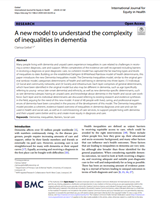A new model to understand the complexity of inequalities in dementia

This paper by Clarissa Giebel at the University of Liverpool introduces a Dementia Inequalities Model. It draws on the pioneering Dahlgren & Whitehead Rainbow model of health determinants (opens new window), taking a look at the evidence of the inequalities experienced by people with dementia and their carers.
The inequalites are categorised in three layers, and and the work also examines the intersectionality between the three levels:
- (i) Individual;
- (ii) Social & Community networks;
- (iii) Society & Infrastructure.
While not housing specific, the paper does highlight key living characteristics that influence inequalities experienced. For example, living situation and carer availability (i.e. rural/urban location, service availability and suitability) and financial situation, (i.e. eligibility to access planned or informal care). The characteristics offer an understanding of the many shapes of dementia inequalities and provide guidance for commissioners and health and social care professionals on how diagnosis and care can be made more equitable for people with dementia and their carers.
